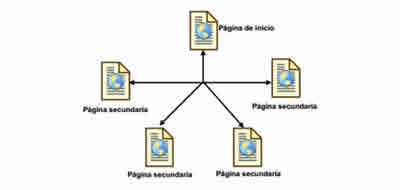HTML what is - Origin of the Hypertext Marking Language
HTML is the acronym of Hypertext Markup Language, the most used on the Web, a language based on labels, which allows displaying Web pages.

HTML is a standard Standardized Markup Language application, a system that allows you to define structured documents and markup languages to represent those same documents.
The term HTML is used to refer to both things, the type of document and the language of marks.
HTML stands for Hypertext Markup Language or hypertext markup language, the most widely used language on the Web, a simple language based on tags, which allows displaying the information of Web pages on the user's monitor through browsers.
NOTE:
When a user requests a Web page from their computer to an Internet server, the HTML document is downloaded to the hard disk and then displayed on the monitor.
In the beginnings of Web design, to create a website you had to inevitably know HTML.
A conventional text editor was also needed to write the code and then check the result. The editors were then relatively simple and impractical to write HTML documents.
The first version of HTML had a primitive labeling that only allowed to define the size of letter, to define the links and to embed the images.
The appearance of new browsers in the market forced to define a standard version of HTML with new ways to make an effective design.
The first visual editors WYSIWYG (What you see is what you get) began to develop in the mid-90s, allowing the production of Websites without the knowledge of HTML.
This contribution was a revolution for page developers, who no longer needed to be programmers to develop good sites.
It is very easy to visualize the source code of a Website. Right-click anywhere on the page, which does not correspond to an image or a form element.
In the context menu that is displayed select "View source code". The HTML code of the page will be displayed in the HTML editor that you have defined.
NOTE:
The main structure of the websites is based on HTML. Currently HTML is used mainly to define structural indicators, such as headings or list elements, although it includes tags that allow you to modify the appearance of the text, insert images, draw tables or establish hyperlinks.
For the visual presentation, now the most sensible and effective is to use the CSS format. The commands that implement the marks are called tags or tags. Each of the HTML tags or tags is written between the symbols (<>) and refers to a specific element of the document, such as an image, a table or text.
In turn, each of these elements have their own attributes that define their characteristics such as shape and size. An HTML document can define other special features such as frames, tables, scripts written in other languages and dynamic effects.
Visual editors have a comfortable and easy to understand interface, which allows to design and edit in a friendly and graphical environment, preserving the option to edit directly in HTML code.
Adobe Dreamweaver belongs to that group of editors that generates HTML code automatically, with the consequent reduction of errors and the acceleration of the production process. Programming the HTML code implies a constant testing process.
If you design directly in HTML, as you incorporate elements you should check the results in the browser, locate the errors and find solutions. If you do not get the expected results you will have to insist on modifying the design.
XHTML stands for eXtensible Hyper Text Markup Language or Extensible Hypertext Marker Language.
XHTML uses the same elements and attributes as HTML but using XML syntax rules that are much stricter and are still in development.
Some HTML development environments, such as Dreamweaver itself, allow formatting the HTML language to the XHTML standard and updating the HTML and XHTML files.
XML has developed a logical standard to define markup languages, the following was to reformulate HTML in an XML application and XHTML: XHTML documents comply with the syntactic rules of XML.
NOTE:
It is common to see HTML and XHTML documents referred to as (x) HTML CSS, Cascading Style Sheets CSS stands for Cascading Style Sheet (cascading style sheets). Although HTML allows you to describe the content of a Web page, CSS is the most effective mechanism for formatting Web elements. Style sheets allow defining the visual presentation of the site: color, size and type of font, background images, margins and placement. With them you can define format options not available in HTML, such as the placement of an object in a specific place on the page or the definition of substitution effects such as the mouse over them.
NOTE:
The great advantage of CSS is that with just a small modification you can change the format of all the documents on the site. You can also modify how documents are presented on other devices and create links to external CSS files. Although you can publish Web pages using only (x) HTML, CSS allows you to keep the presentation instructions separate from the content and structure of the document. Style sheets are supported by almost all modern browsers.
Script languages by itself HTML is a static language, this means that you can not make variations once the page is loaded.
In this context, scripting languages acquire a singular importance, which allow tasks to be performed, such as calculations, data editing and changes in visual presentation. Of these languages scripts for browsers the best known is JavaScript.
JavaScript allows you to create small programs to perform certain actions in the scope of a Web page such as substitution images.
Dreamweaver allows you to enter these scripts, without the need to have programming knowledge.
All modern browsers interpret the integrated JavaScript code in the Web page.
CITE ARTICLE
For homework, research, thesis, books, magazines, blogs or academic articles
APA Format Reference:
Delgado, Hugo. (2019).
HTML what is - Origin of the Hypertext Marking Language.
Retrieved Nov 09, 2025, from
https://disenowebakus.net/en/html







Loving the info on this site, you have done outstanding job on the blog posts.
My brother recommended I would possibly like this web site. He used to be totally right. This put up actually made my day. You can not imagine just how much time I had spent for this information! Thanks!
This is my first time pay a visit at here and i am in fact impressed to read all at single place.
Thank you for the auspicious writeup. It in fact was a amusement account it. Look advanced to more added agreeable from you! However, how could we communicate?
Hi there i am kavin, its my first occasion to commenting anyplace, when i read this post i thought i could also create comment due to this good post.
Pretty! This was an incredibly wonderful article. Thank you for providing this information.
Good way of explaining, and nice post to obtain facts about my presentation focus, which i am going to convey in school.
Great information. Lucky me I recently found your website by accident (stumbleupon). I have book-marked it for later!
I am truly grateful to the owner of this site who has shared this enormous piece of writing at at this time.
Hello there! This is my first visit to your blog! We are a team of volunteers and starting a new project in a community in the same niche. Your blog provided us valuable information to work on. You have done a marvellous job!
El término HTML se usa para referirse a ambas cosas, al tipo de documento y al lenguaje de marcas.